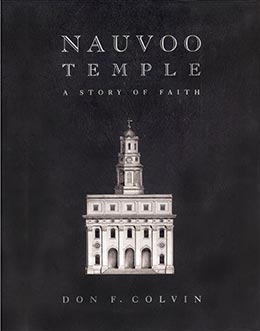Exterior Features
Don F. Colvin, “Exterior Features,” in Nauvoo Temple: A Story of Faith (Provo, UT: Religious Studies Center, 2002), 129–64.
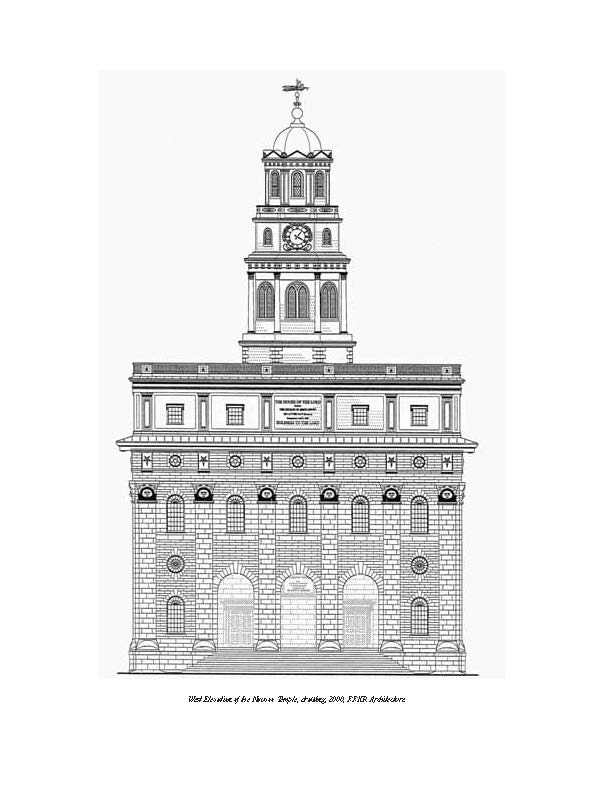 Travelers on the upper Mississippi in the mid 1840s could hardly escape viewing the prominent features of the temple as they approached Nauvoo. The city was located on a horseshoe bend of the river, and the spire of its principal structure was visible from a distance of twenty or thirty miles. [1]
Travelers on the upper Mississippi in the mid 1840s could hardly escape viewing the prominent features of the temple as they approached Nauvoo. The city was located on a horseshoe bend of the river, and the spire of its principal structure was visible from a distance of twenty or thirty miles. [1]
The building stood on the summit of a gently sloping bluff overlooking the lower town and the river. It was one of the choicest lots in the city. Charles Lanman, a western traveler, noted that “in the centre of this scene . . . stands the Temple of Nauvoo, which is unquestionably one of the finest buildings in this country." [2]
The temple faced to the west with its tower and main entrances on that end of the structure. [3] Frontage of the building was on what is now Wells Street, somewhere near the center of the block. The temple block was additionally bounded by what is now Bluff Street on the east, Mulholland Street on the south, and Knight Street on the north.
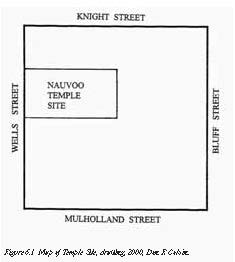
Nauvoo “was a prime attraction to Mississippi River tourist traffic . . . and the Nauvoo Temple [was an object] of particular interest. [4] It was reported that as early as mid-1843 four or five steamers a day would stop at Nauvoo. [5] A popular pastime with the citizens and visitors of the city was to climb either of the winding stairways and behold the view afforded from the lofty tower of the temple. The view furnished from this vantage point was described with numerous adjectives by its patrons. The historian Thomas Gregg left this impression: "I took several occasions to look at the city and surrounding country from the top of the Temple. It is, indeed, a grand and imposing scene, and presents the most magnificent view to be found anywhere on the banks of the Mississippi." [6]
Another observer remarked: “The scene is rendered highly picturesque by being interspersed with large rolling praries, and relieved here and there, with groves of green wood, and tracts of woodland. Westward spreads ‘the flat’ all over which looms up the massive walls of hundreds of residences. . . . Beyond the river spreads the wood lands of Iowa, sprinkled here and there, with farm houses and cultivated fields. The little village of Montrose clusters upon the opposite bank." [7] In all, one could see for miles in all directions.
Architecture
Probably no building in early America could be compared with the Nauvoo Temple as a prototype from which it had been copied. The building was a complexity of architectural designs, familiar and yet different from anything in ancient or modern history. [8] It was said to be "in style of architecture which no Greek, nor Goth, nor Frank ever dreamed . . . the style of architecture is exclusively the Prophet's own, and must be known as the Mormon Order." [9] Charles Lanman described it as "principally after the Roman style of architecture, somewhat intermixed with Grecian and Egyptian." [10] Joseph Fielding declared: “The Temple is indeed a noble Structure, and I suppose the Architects of our Day know not of What Order to call it Gothic, Dorick, Corinthian or What I call it Heavenly." [11]
The temple was a product of Joseph Smith, who planned its architecture in line with his concept of the building’s purposes and supervised the project during much of its construction. The actual drawings were done by William Weeks, who drafted them under dictation of the Prophet. [12] Laurel Andrew explained: “Weeks’ designs demonstrate his familiarity with the traditions of New England, but they are also a testament to the influx of modern ideas of the 1840’s as transmitted primarily through the medium of architectural handbooks. His final plans do not depend on a specific source, and are novel in their . . . motifs, demonstrating, by comparison with the earlier plans, a greater proficiency in handling the architectural vocabulary." [13] Andrew goes on to explain that “the belief fostered by the Prophet that Weeks drafted the plans entirely under his dictation is no doubt true to a certain extent, but the building from its earliest stages clearly manifests a more sophisticated acquaintance with architectural styles . . . the most plausible assessment of each man’s part in the building is to assign to Weeks those elements which are purely architectural, while crediting the determination of functional and symbolic requirements to the President himself." [14]
Source materials showing or describing the Nauvoo Temple are incomplete and sometimes contradictory. Surviving architectural sketches are few in number, and many of them are preliminary drawings. It is evident (based on comparison between daguerreotypes and architects’ drawings) that changes and modifications were made in the final working plans and during construction.
Complete and accurate records were never made, or were not preserved, or else were lost due to the persecutions and forced exodus to the West. Various observations and reports are available, but these are not all consistent with each other. Available sketches and photographs are very helpful in determining external features of the building but not always satisfactory to verify the accuracy of written accounts regarding size, measurements of the building, some of its ornamental details, or its various parts.
Careful, detailed research, consultation with Church architects both past and present, and study and analysis of all available source materials lead to conclusions that provide the most likely and relatively accurate picture of what the temple was like. Future discovery of additional source material and data will either verify or cause revision of these impressions.
Size of the Temple
Over the years, several different sets of external measurements have been reported, causing some confusion regarding the temple’s size. [15] Measurements of the building’s interior are clearly established and are consistent in the various written reports, along with architectural sketches and excavation reports. Internal measurements are uniformly shown to be 80 feet wide by 120 feet long. These figures are consistent on each floor level as explained with detailed verification in chapter 8. External dimensions of the building are most often described as either 88 feet by 128 feet [16] or 90 feet by 130 feet. [17] Both sets of figures are noted in several accounts and can be accepted as accurate depending on where (at what height) the measurements are taken. By adding the thickness of the walls to the well-established internal measurements, it is possible to determine the external dimensions, though it again depends on where the measurements are taken. It is most likely that the outside dimensions of the temple at the basement walls below ground level were 90 feet wide by 130 feet long. [18] The thickness of the walls is explained in the next section and can be studied by careful examination of Figure 6.2. The building was composed of a basement story, first story, second story, and a fully functional attic story. Each of the two main stories contained a mezzanine, or half-story, on each long side of the building in the recesses outside the central archway on each floor. Round windows in the half-stories made the structure look more like a four-story building with an “arrangement of two major and two minor divisions." [19] The attic story was divided into two parts—a regular sloping or gabled attic over the main part of the building and a rectangular boxlike structure on the west or front end of the building. Rising from the center of this front attic section was the tower or steeple. At the top of the steeple the structure is described as rising to an overall height of 158½ feet. [20] A careful study of the original architectural plans and drawings establishes the height as 156 feet 5 inches from ground level to the top of the steeple.
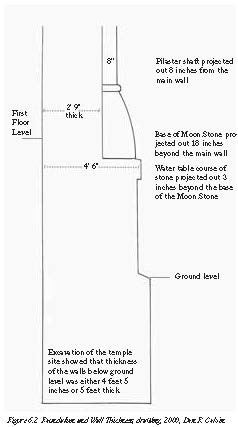
The Walls
The walls of the temple represented a monumental task in building. They were an imposing work worthy of admiration. The building was mainly constructed of “fine white” native limestone, which resembled marble. [21]
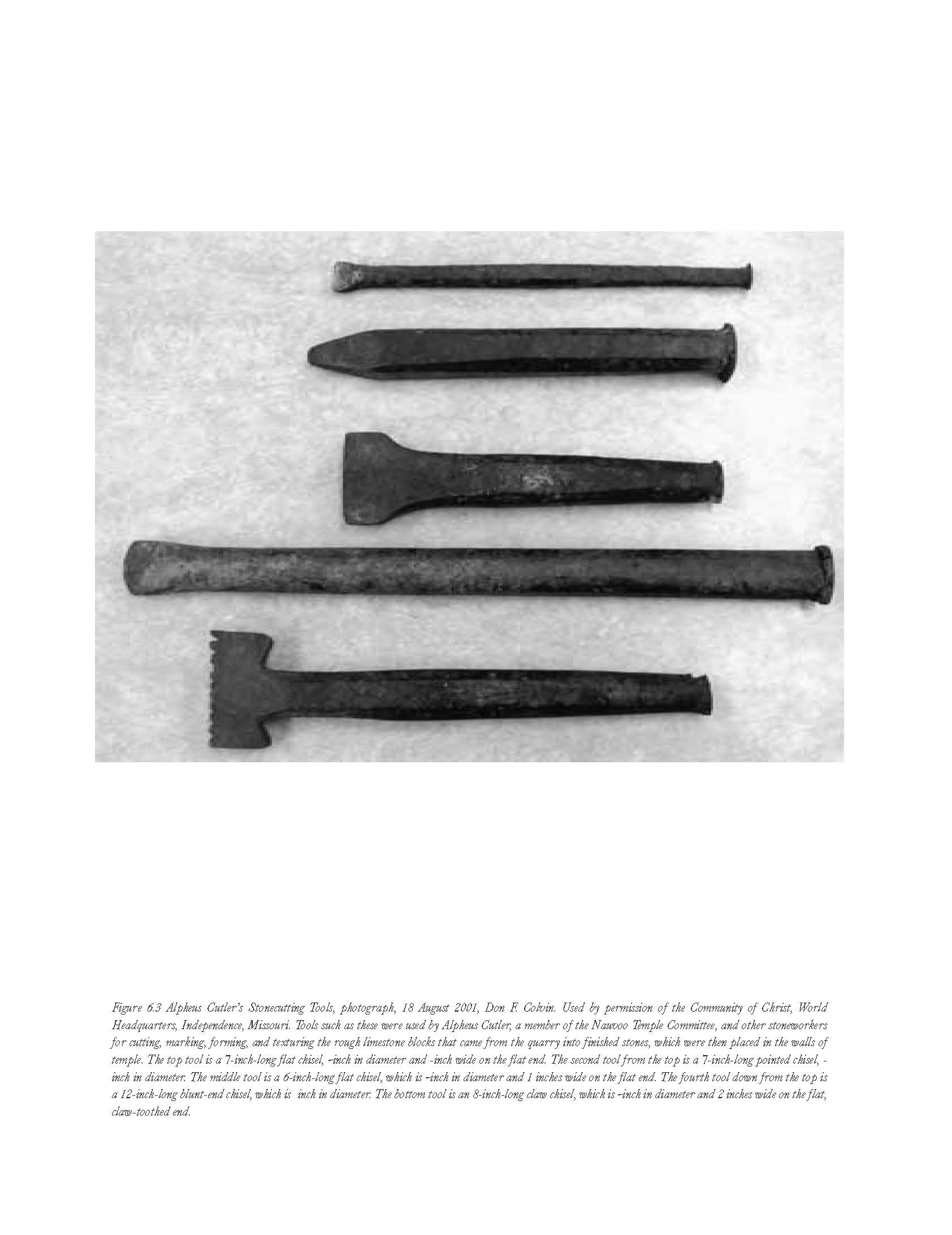
Stones placed in the wall had been finished with great skill and were described as being _dressed with considerable neatness," [22] and “worked and forced down to a perfect surface." [23] They “present a fine appearance when finished." [24] Archeologists excavating the temple site in the 1960s found several pieces of stones in the rubble. They concluded that stones placed in the temple walls had been “given an overall tooled finish, and a border of about 1½ inches of channeling at right angles, or nearly so, to the edges. Stones used at corners could be identified by this finish on two adjacent sides." [25] A tooled 1½- or 2-inch border channeling was consistently used on stones at the corners of the building, at edges around window openings, and on the water table course of stones surrounding the entire building at the top of the foundation. Examples of these tooled borders can be viewed in Figure 6.5. The main wall panels between pilasters were believed to have been composed of stones having a vertical-striation textured finish, as shown in Figure 6.4. The pilaster shafts were composed of stones with a sanded or smooth untextured finish, while those used in the water table course of stones as well as those in the wall panels below them received a basket-weave textured finish enclosed within a channel-edged border (see Figure 6.5). Stones around the top arch of the large main windows, around all of the round windows, and surrounding the three arched entrances into the front vestibule all received a stipple-textured finish enclosed within a channel-edged border (see Figure 6.6). [26] Stones in the frieze area (the 6-foot-high portion of the entablature) at the top of the walls appear to have received a rough or plain rustic finish. The tremendous effort, detail, and skill of the stoneworkers drew praise from viewers. One observer declared that the temple “is certainly an extraordinary specimen of human skill and industry." [27] Visitors impressed with both the exterior and the interior features of the temple were “continually astonished at the quality of material, and the accuracy and perfection exhibited in the completion of every part." [28]
The walls were strong and massive. They were made with an outer facing of heavier stones with rough, mostly irregular stones behind, all laid together with lime mortar. The procedure followed in laying the walls “was to lay the cut and tooled face stones first, which were of varying depth, into the wall; then to lay the backup or masonry in a solid mass behind the face stones. Some face stones were much thicker than others, allowing bonding through the wall to form a unified mass." [29] The walls’ thickness is variously described. One visitor to Nauvoo estimated them as 4 to 6 feet thick. [30] Another described them as about 3 feet thick in the basement by the baptismal font, [31] and still another as being at least 2 feet thick near the top of the walls. [32] One additional report described them as “of solid stone, four feet in thickness." [33] Accuracy on the thickness of the walls can now be established by examination of original architectural sketches and archeological evidence. The main outside stone walls are indicated by one preliminary drawing as being 2 feet 9 inches thick (see Figure 2.3). Another drawing, of an area around the main south front stairwell, shows the walls as 2 feet 10 inches thick (see Figure 7.10). The thickness of the walls was increased at the location of each of the thirty pilasters. The main shafts of these pilasters were 8 inches thicker than the wall panels between them. The sun stone or capital at the top of each pilaster extended out 17 inches, and the moon stones at the bottom of each pilaster shaft projected out 18 inches beyond the main wall. The thickest portion of the walls above ground level was where the water table course of stones encircled the building. This stone molding extended out an additional 3 inches beyond the bottom of each moon stone. The thickness of the walls in this area was 4 feet 6 inches. Each pilaster base (from ground level up to the water table stone molding) was either 19 or 20 inches thicker than the main wall, making the overall thickness of the walls at the pilaster base at least 4 feet 4 inches thick (see Figure 6.2). A close examination of the Chaffin daguerreotype (see Figure 5.4) indicates that the walls beneath the basement windows provided a sill, which appears to be part of a solid wall structure. This wall extended beyond the area under the window to cover the full space between pilaster bases. All of this leads to the conclusion that the walls of the temple from the footings up to the ground level were most likely 5 feet thick. Walls under the front steps and in the corners of stairwells at the front of the building were easily 6 or more feet in thickness.
The size of the stones varied depending on their function. Most were uniform in size and shape, but others may have reached a reported weight of over four thousand pounds. [34] Some individual stones around each of the main windows on the outside wall bays are shown on sketches by the architect to be in courses of stone measuring 6½, 7½ and 10 inches in height (see Figure 7.7). The length of stones in the wall bays also varies, but most appear to be about 24 inches long. Some stones taken from the temple ruins and used in other later buildings of Nauvoo have been measured as follows:
Length Width Thickness
2 feet 11 inches 10 inches
2 feet 11 inches 16 inches 12 inches
3 feet 16 inches 14½ inches
3 feet 8 inches 12 inches 13_ inches
4 feet 16 inches 8 inches
4 feet 4 inches 2 feet 6½ inches 16 inches [35]
Rising from beneath the surface of the earth, walls at the square of the building were reported to have attained an overall height of some 60 feet above ground level. [36] This was up to the eaves of the second story and was as high as the stonework went, except for chimneys and possibly the railing piers of the balustrades. The stone walls started in the basement area 5 or 6 feet below ground level. [37] These foundation walls had no footings and commenced where large irregular loose stones were laid directly upon the native yellow clay of the basement excavation, cemented together with mortar. [38] Foundation walls were 12 feet high, having half of their elevation below the ground level. [39] They were apparently installed under the direction of the temple committee prior to the architect taking over full supervision of the project. This is the one area that Truman O. Angell described as “much botched” by them. [40] Foundation walls were laid in March 1841, four months prior to the decision in July to build a font in the basement. When the baptismal font was constructed, more head room was required in the center of the basement at the font area. Rather than tear out basement walls and footings, they scooped out the center of the basement to accommodate the need for 4 additional feet of height. The floor of the basement was then sloped down from the sides and ends to the center at the font. This is explained in detail in chapter 8. Measuring from the floor to the crown of the arched ceiling, the inside height of the first story measured 25 feet (see Figure 7.1 ). The second story, largely a duplicate of the first, was of the same height (see Figure 7.1). Recesses between the arch and the outside wall on each of the two main floors made it possible to form or build a half-story at each level on both sides of the building (see Figure 7.1 and Figure 12.5). Preliminary architectural drawings have 30 feet penciled in on the plans for each of the two stories as well as 16 feet penciled in for the basement story (see Figure 7.1). We know for certain from archaeological excavation reports that even though the walls of the basement story remained at 12 feet, the floor area inside the walls was hollowed or scooped out in the center an additional 3 to 4 feet. This was done, as explained, to provide adequate head room above the baptismal font and resulted in increasing the basement height from 12 feet to 16 feet in the font area. It has now been established (by careful scaling of the daguerreotypes and study of billing records) that the penciled-in changes of height for upper portions of the building were never followed. The possible change in height may have been considered when Joseph Smith ordered that round windows be placed in the building to give light to the offices between stories.
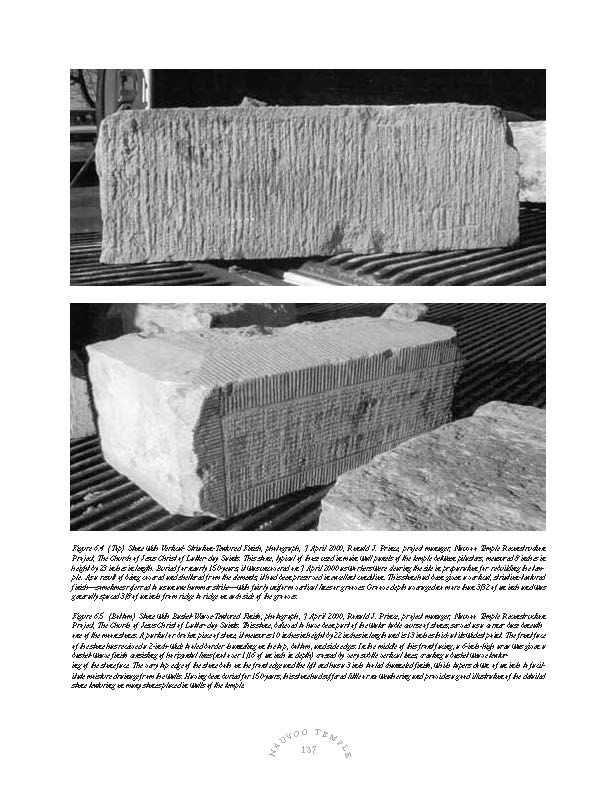 In the afternoon [5 February 1844], Elder William Weeks (whom I had employed as architect of the temple,) came in for instruction. I instructed him in relation to the circular windows designed to light the offices in the dead work of the arch between stories. He said that round windows in the broad side of a building were a violation of all the known rules of architecture, and contended that they should be semicircular_that the building was too low for round windows. I told him I would have the circles, if he had to make the temple ten feet higher than it was originally calculated; that one light at the centre of each circular window would be sufficient to light the whole room; that when the whole building was illuminated, the effect would be remarkably grand. “I wish you to carry out my designs. I have seen in vision the splendid appearance of that building illuminated, and will have it built to the pattern shown me." [41]
In the afternoon [5 February 1844], Elder William Weeks (whom I had employed as architect of the temple,) came in for instruction. I instructed him in relation to the circular windows designed to light the offices in the dead work of the arch between stories. He said that round windows in the broad side of a building were a violation of all the known rules of architecture, and contended that they should be semicircular_that the building was too low for round windows. I told him I would have the circles, if he had to make the temple ten feet higher than it was originally calculated; that one light at the centre of each circular window would be sufficient to light the whole room; that when the whole building was illuminated, the effect would be remarkably grand. “I wish you to carry out my designs. I have seen in vision the splendid appearance of that building illuminated, and will have it built to the pattern shown me." [41]
All documentary accounts, however, support the conclusion that the proposed changes were not required and windows were put into the building without adding any additional height. Careful examination of architectural sketches, and measurements of parts found in billing records, along with measuring and scaling of the various daguerreotypes, clearly support this view.
The Pilasters
The pilasters that formed a prominent part of the wall structure were a notable feature of the stonework. Jutting out from the wall surface, they numbered thirty in all, with nine on each long side and six on each end of the building. [42] Their design, including moon and sun stones along with the star stones immediately above them, was a remarkable feature of the temple. No clear explanations on the meaning or representation of these symbols on the Nauvoo Temple have been reported in the writings of the architect or early Church leaders. It has generally been accepted by Church members that these representations of the sun, moon, and stars gave emphasis to a theological concept symbolizing the three degrees of glory. [43] It is a religious concept fully embodied in the sacred purposes for which the building was erected. Commencing at their base below ground level, the pilasters ascended nearly to the eaves at the top of the wall. They were readily distinguished by the moon stone, located at the foundation level, and the sun stone, which was part of the capital or top of each pilaster. The total cost of each pilaster was estimated at three thousand dollars at a time when stone masons’ pay was less than two dollars per day. [44]
Beneath each pilaster and commencing at ground level was a stone base 6 feet 2 inches wide. [45] This pilaster base column, 20 inches thicker than the main bays of the wall, was made up of several stones. Resting on top of each pilaster base and boldly projecting from it was a “water course” stone molding. This stone molding can be seen on the daguerreotypes projecting from the wall not only at the top of the pilaster base but also extending into the wall bays. According to architectural drawings and careful study of the daguerreotypes, this stone molding was about 11 inches in thickness or height and extended out 2 or 3 inches beyond the pilaster bases and wall bays (see Figure 6.2). This water course stone molding separated the pilaster base from the plinth (moon stone) and pilaster shaft above. It provided a borderline course of stone surrounding the entire building, marking a division between the foundation and the rest of the building. As the walls were being constructed, it was reported that vertical recessions were placed “at regular intervals around the foundation to form the plinths or heavy stone bases, on the top of which rested the less heavy wall pilasters." [46] The plinth stones here mentioned were in reality the moon stones, which served as a solid support for the shaft of each pilaster. A good representation of the pilasters is furnished in Figure 6.13.
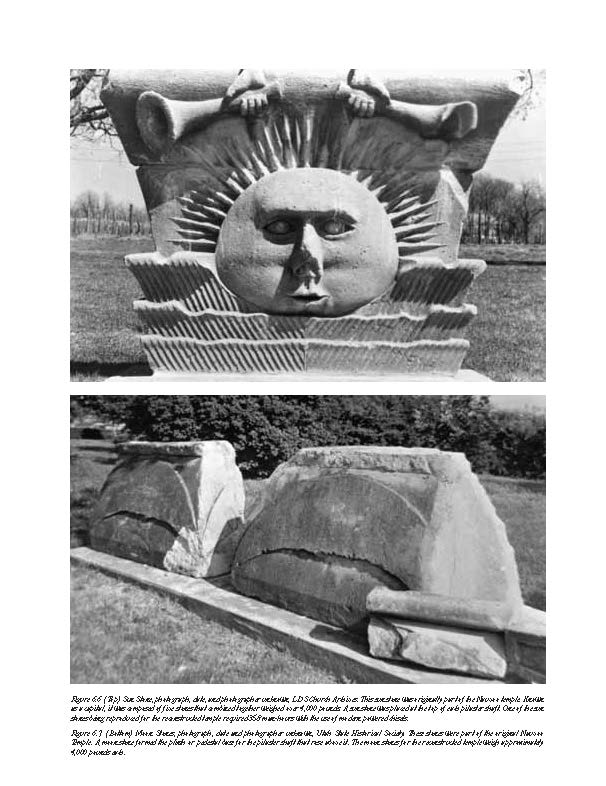 Moon Stones, Sun Stones, and Star Stones Moon stones, each carved from one piece of solid stone, [47] rested on top of the foundation at the commencement of the first story. They were a relief representation of a crescent moon with the crescent facing downward. Forming the plinth or base of each pilaster, they rested on the water table course of stone and served as the bottom or pedestal support of each pilaster shaft. Each moon stone was 6 feet 2 inches in width at its bottom or base. It rose to a height of 3 feet 4 inches, where the width diminished to 4 feet 6 inches at the top of its juncture with the main shaft of the pilaster. [48]
Moon Stones, Sun Stones, and Star Stones Moon stones, each carved from one piece of solid stone, [47] rested on top of the foundation at the commencement of the first story. They were a relief representation of a crescent moon with the crescent facing downward. Forming the plinth or base of each pilaster, they rested on the water table course of stone and served as the bottom or pedestal support of each pilaster shaft. Each moon stone was 6 feet 2 inches in width at its bottom or base. It rose to a height of 3 feet 4 inches, where the width diminished to 4 feet 6 inches at the top of its juncture with the main shaft of the pilaster. [48]
Composed of many individual stones, each pilaster shaft measured 4 feet 6 inches wide, projected out 8 inches from the wall bays (see Figure 6.2), [49] and rose to a height of 50 feet from the ground level (including the base beneath the moon stone) to the top of the sun stone. [50]
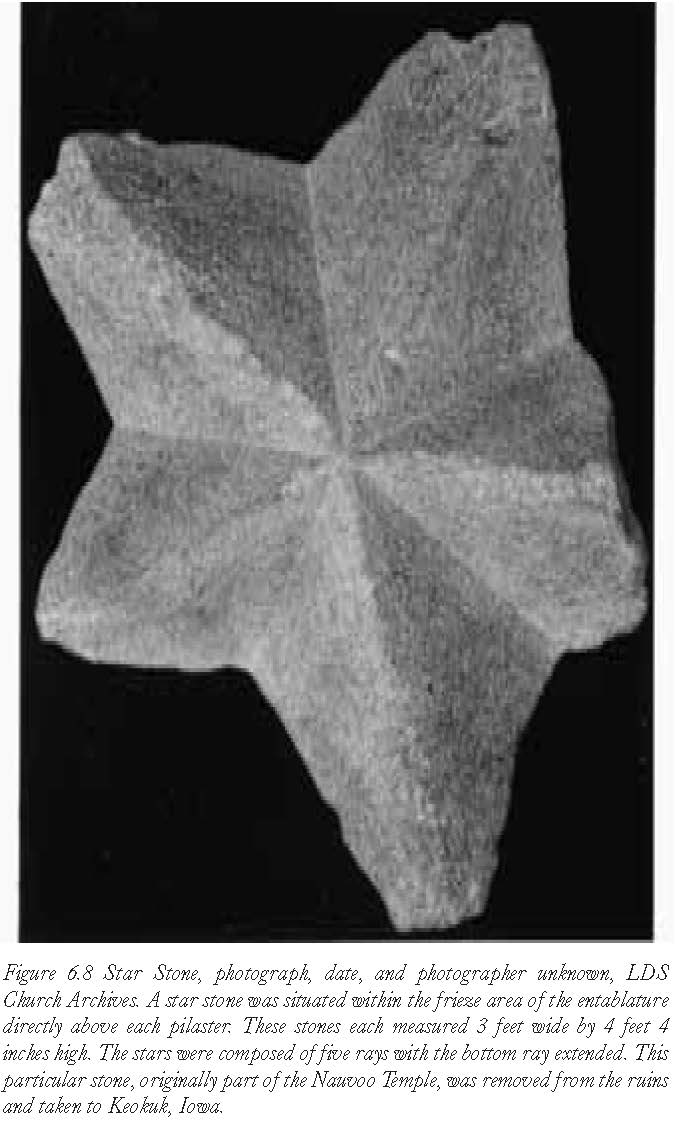 On top of each pilaster shaft was a capital that included an image of the sun. Each capital was estimated to weigh over two tons and consisted of five different stones. [51] The bottom of each capital where it joined the main shaft of the pilaster was 4 feet 5 inches in width. The capital rose 4 feet 9 inches high and widened to a width of 6 feet at the top. It projected out 8 inches from the wall at its base and 17 inches at its crest. [52] The sun stones were part of the capitals that formed the top of each pilaster. These capitals were well described by Brigham Young on the occasion of laying the last capstone. He stated: “There are thirty capitals around the Temple, each one composed of five stones, viz., one base stone, one large stone representing the sun rising just above the clouds, the lower part obscured; the third stone represents two hands each holding a trumpet, and the last two stones form a cap over the trumpet stone, and these all form the capital, the average cost of which is about four hundred and fifty dollars each. These stones are very beautifully cut, especially the face and trumpet stones, and are an evidence of great skill in the architect and ingenuity on the part of the stonecutters. They present a very pleasing and noble appearance, and seem very appropriate in their places." [53] The sun stone and moon stone can be examined by viewing Figures 6.2 and 6.8.
On top of each pilaster shaft was a capital that included an image of the sun. Each capital was estimated to weigh over two tons and consisted of five different stones. [51] The bottom of each capital where it joined the main shaft of the pilaster was 4 feet 5 inches in width. The capital rose 4 feet 9 inches high and widened to a width of 6 feet at the top. It projected out 8 inches from the wall at its base and 17 inches at its crest. [52] The sun stones were part of the capitals that formed the top of each pilaster. These capitals were well described by Brigham Young on the occasion of laying the last capstone. He stated: “There are thirty capitals around the Temple, each one composed of five stones, viz., one base stone, one large stone representing the sun rising just above the clouds, the lower part obscured; the third stone represents two hands each holding a trumpet, and the last two stones form a cap over the trumpet stone, and these all form the capital, the average cost of which is about four hundred and fifty dollars each. These stones are very beautifully cut, especially the face and trumpet stones, and are an evidence of great skill in the architect and ingenuity on the part of the stonecutters. They present a very pleasing and noble appearance, and seem very appropriate in their places." [53] The sun stone and moon stone can be examined by viewing Figures 6.2 and 6.8.
Above the pilaster system was the stone entablature that extended to the top of the wall and girded the building at its height. The entablature overhung the walls by 8 inches, matching the projection of the pilaster shafts below. This entablature was divided into an architrave “belt course of stone, and then six feet of plain cut stone." [54] Within this plain cut stone area were smaller round windows that provided light to the second half-story. Also in this area, a short distance above the capitals or tops of each pilaster and directly in line with them, were the star stones. The base or encasement of each star stone measured 3 feet 1½ inches wide by 6 feet high. The star stone itself measured 3 feet by 4 feet 4 inches and projected out 3 inches from the wall face (see Figure 6.11). The base itself appears to have projected out 6 or 8 inches from the wall. This symbolic decoration was composed of large stars with five or rays, with the bottom ray elongated. They were positioned in the entablature just below a large, beautiful cornice, which ran around the eaves of the building. These star stones are easily visualized in the architect’s drawing and in photographs (see Figures 6.11 and 6.9).
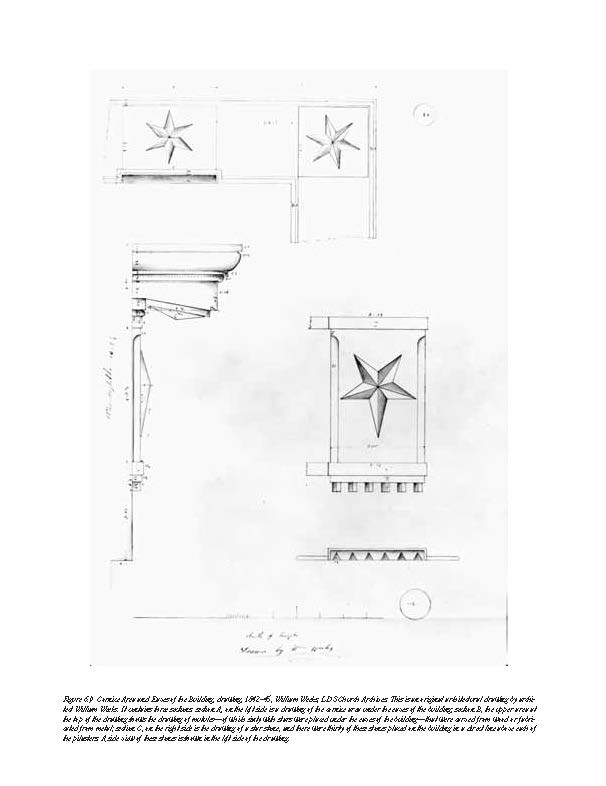
Cornice and Eaves Above the stone walls were the eaves of the building, which projected at least 4 feet over the walls. An observer standing near the building looking up under the eaves could not help but be impressed by another symbolic decorative feature in the cornice area on the underside of the eaves. This cornice projection contained sixty stars, which each placed within square mutules. These mutules are shown in Weeks’s drawings to be 21 inches square, and they made up the largest part of the cornice area under the caves. Close photographic analysis has proven that the cornice, eaves, and mutules were all built considerably larger than originally drawn by Weeks. The mutules as a part of the cornice were each “ornamented on the lower side with large stars,” carved in wood or fashioned from hammered metal sheets (see Figure 6.11). [55] There was one of these stars directly above each of the small windows, as well as above each star stone and one at each corner of the cornice surrounding the entire building. Each star was in relief 3½ inches at the center, and the points receded in relief as they extended outward over the mutule surface (see Figure 6.11). Stars in this area were six pointed, as will be noted in the architectural drawings (see Figure 6.11). Several stars carved in wood or stone, or fashioned from metal, were also located on panels of the balustrades. An additional forty stars can be seen on the fascia at the top of the belfry. There is also some indication in enlargements of the Chaffin daguerreotype that additional stars may have been located on the fascia below the dome and just above the observatory level of the tower. These, along with the angelic weather vane, completed the placing of heavenly symbols on the exterior of the temple.
The Attic Sections
Above the stone walls on the west end of the building rose the front attic story, often referred to as the half-story. This boxlike rectangular attic section on the front of the building measured 86 to 87 feet long from north to south, essentially the same width as the main building. It extended back 36 to 37 feet in width and rose 16½ feet in height above the eaves of the main wall. [56] The roof of this section was relatively flat with a slight slope (see Figure 7.2). It was enclosed by a balustrade, or railing, of beautiful workmanship, which extended around the front of the structure. [57] This section of the building was lighted by eight rectangular windows about 4 feet wide and 5 feet high. There was room in the wall on the east side of this box attic for two more windows above the slope of the east attic roof; but it is not known if any windows were built in this area. Directly under the tower and on the front side of this attic section was an inscription in golden letters. It read:
The House of the Lord
Built by
The Church of Jesus Christ of Latter-day Saints
Commenced April 6, 1841.
Holiness to the Lord
The entire attic story was constructed of wood and composed of two sections. The main attic section extended back to the east, stretching over the central part of the building. Inside it measured 88 feet 2 inches long by 56 feet 8 inches wide and was not quite as high as the west attic section. [58] The pitched roof structure of this main attic was pierced by two elegant chimneys on each side of the roof. They were made of hewn stone. [59] At the peak of this attic roof was a balustrade that enclosed a promenade on the decked roof of this area. The pitched roof of this attic was covered by white pine shingles “perfectly matched and laid in the neatest manner." [60] Light was provided to this east attic area by skylights in the roof along with a large window in the east end.
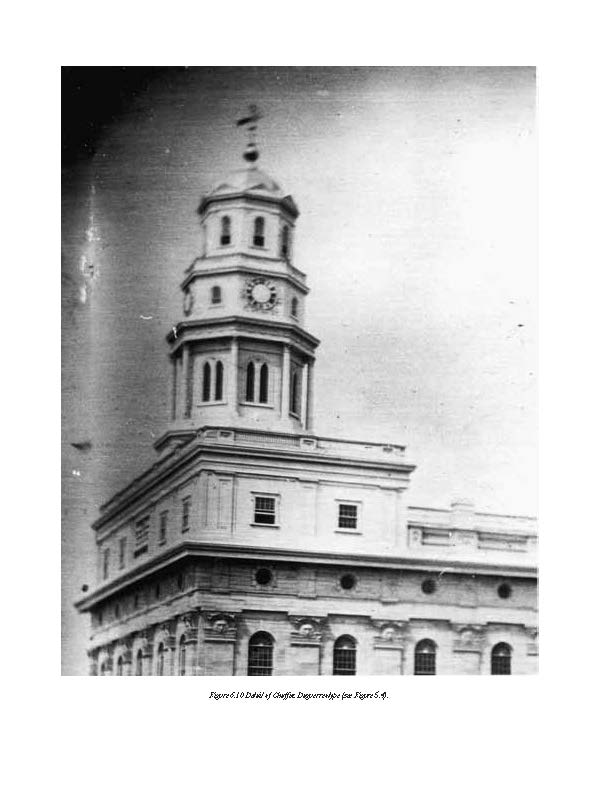 The Tower or Steeple Rising with a telescopic effect above the front attic section of the temple was an octagonal tower. It added an attractive and imposing appearance to the building. The base section rose from the top of the 16½-foot-high attic, extending 12½ feet above it. This section along with its support structure in the attic section below measured 29 feet in diameter (see Figure 7.3). On the east side of this tower base, a small door opened onto the decked roof of the main or east attic section. [61] Above the tower base was the belfry section, somewhat narrower (22 feet in diameter) and rising 20 feet in height. In between the shuttered window openings and standing out from the outer walls of the belfry section were pillars or columns, which supported the well-decorated cornice and eaves above. This is clearly visible on the enlarged section of the Chaffin daguerreotype (see Figure 6.10). Next came the clock section (also 22 feet in diameter) rising 10 feet 8 inches above the belfry below. The last section (17 feet in diameter) was the observatory, which rose an additional 16 feet and provided a balcony for all-around observation purposes. The dome section added another 7 feet 10 inches to the height of the steeple and appears to be about 13 to 14 feet in diameter at its base (see Figure 7.8). Divided into eight sections, it corresponded to the octagonal shape of the steeple (see Figure 6.10). Covered with tin or zinc, it was a “silvery capped dome." [62] Two openings in the top provided access to the rod at the summit of the steeple. A small ladder could be seen going up over the dome. [63] Coming out from the top of the dome was the ball and rod that rose 12 feet 8 inches higher, supporting an angelic weather vane. [64]
The Tower or Steeple Rising with a telescopic effect above the front attic section of the temple was an octagonal tower. It added an attractive and imposing appearance to the building. The base section rose from the top of the 16½-foot-high attic, extending 12½ feet above it. This section along with its support structure in the attic section below measured 29 feet in diameter (see Figure 7.3). On the east side of this tower base, a small door opened onto the decked roof of the main or east attic section. [61] Above the tower base was the belfry section, somewhat narrower (22 feet in diameter) and rising 20 feet in height. In between the shuttered window openings and standing out from the outer walls of the belfry section were pillars or columns, which supported the well-decorated cornice and eaves above. This is clearly visible on the enlarged section of the Chaffin daguerreotype (see Figure 6.10). Next came the clock section (also 22 feet in diameter) rising 10 feet 8 inches above the belfry below. The last section (17 feet in diameter) was the observatory, which rose an additional 16 feet and provided a balcony for all-around observation purposes. The dome section added another 7 feet 10 inches to the height of the steeple and appears to be about 13 to 14 feet in diameter at its base (see Figure 7.8). Divided into eight sections, it corresponded to the octagonal shape of the steeple (see Figure 6.10). Covered with tin or zinc, it was a “silvery capped dome." [62] Two openings in the top provided access to the rod at the summit of the steeple. A small ladder could be seen going up over the dome. [63] Coming out from the top of the dome was the ball and rod that rose 12 feet 8 inches higher, supporting an angelic weather vane. [64]
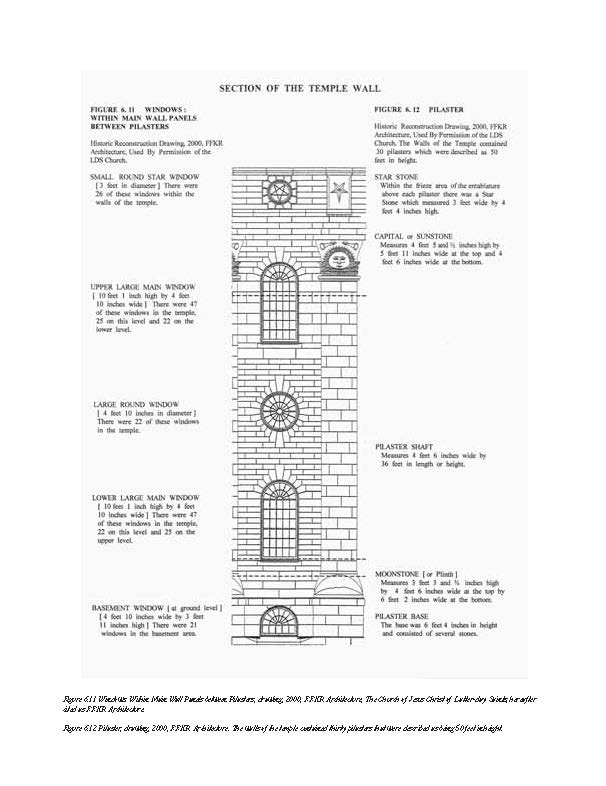 Plans were made early to have the ball and rod at the summit of the tower, ornamented by a horizontal figure of a flying angel. According to the sketches of the architect, it was to be about 5 feet long (see Figure 7.4). The installed angelic weather vane was described as being 7 feet in length and formed of some substantial metal, which some thought to be bronze but was more likely tin or zinc. [65] On 19 December 1845 the Tinners Association submitted a bill for labor on the temple. This bill included twenty-four days of labor for making the vane and nine days of labor making balls and ornaments for the spire. [66] The vane was attached in place at the top of the steeple on 30 January 1846. [67] It has been concluded that it was fastened in a position horizontal to the ground in such a way as to revolve in the wind. [68] Perrigrine Sessions reported: “On this day they raised the veign [vane] which is the representation of an Angel in his Priestly robe with the book of Mormon in one hand and a trumpet in the other which is over lain with gold leaf." [69] This angelic figure was described as being “gilded like burnished gold." [70] On 2 August 1845 the temple committee ordered from the firm of Bacon and Hyde, “60 books of gold leaf." [71] On 17 November 1845 the committee purchased from Amos Davis a “pack of gold leaf." [72] Part of these purchases may have been used to gild the angel weather vane as well as the balls ornamenting the spire. “The bronze ball [also apparently covered with gold leaf], and silvery capped dome” were described as “[appearing] like a blazing star in the firmament." [73]
Plans were made early to have the ball and rod at the summit of the tower, ornamented by a horizontal figure of a flying angel. According to the sketches of the architect, it was to be about 5 feet long (see Figure 7.4). The installed angelic weather vane was described as being 7 feet in length and formed of some substantial metal, which some thought to be bronze but was more likely tin or zinc. [65] On 19 December 1845 the Tinners Association submitted a bill for labor on the temple. This bill included twenty-four days of labor for making the vane and nine days of labor making balls and ornaments for the spire. [66] The vane was attached in place at the top of the steeple on 30 January 1846. [67] It has been concluded that it was fastened in a position horizontal to the ground in such a way as to revolve in the wind. [68] Perrigrine Sessions reported: “On this day they raised the veign [vane] which is the representation of an Angel in his Priestly robe with the book of Mormon in one hand and a trumpet in the other which is over lain with gold leaf." [69] This angelic figure was described as being “gilded like burnished gold." [70] On 2 August 1845 the temple committee ordered from the firm of Bacon and Hyde, “60 books of gold leaf." [71] On 17 November 1845 the committee purchased from Amos Davis a “pack of gold leaf." [72] Part of these purchases may have been used to gild the angel weather vane as well as the balls ornamenting the spire. “The bronze ball [also apparently covered with gold leaf], and silvery capped dome” were described as “[appearing] like a blazing star in the firmament." [73]
Evidence that an angel was installed is plentiful. A person visiting the temple in 1846 described a glittering angel with a trumpet in his hand, near the top of the steeple. [74] This report is substantiated by the testimony of Thomas L. Kane, who likewise visited the building in 1846. He stated that the Saints had remained in Nauvoo and succeeded, in spite of opposition, in completing the temple, "even the gilding of the angel and trumpet on the summit of its lofty spire." [75] Another witness of the angel’s existence was the Prophet's young son Joseph Smith III. He recorded that he watched the building rise from its foundation to "the gilded angel that swung at the top of the spire." [76] Enlarged copies of the Chaffin daguerreotype show what appears to be the angelic weather vane in a horizontal position at the top of the spire. The most likely conclusion is that this photograph shows the angel or angelic weather vane in place at the top of the spire during the summer of 1846 (see Figure 6.10). The possible fate of this angelic weather vane is discussed in chapter 11.
Observers described the overall height of the building from ground level to the top of the rod at the summit of the steeple as 158½ feet. [77] A careful study of the original architectural plans and drawings establishes the height as 156 feet 5 inches.
The tower was richly ornamented with many cornices and one level of Corinthian pillars. [78] Emblems were carved on many of the different pieces of the tower, making this area a very attractive as well as functional part of the structure. [79] The tower itself was painted white except for the shutters, which were painted green. [80]
Tower Dimensions Based on Original William Weeks Drawings Section Height External Diameter
Base or pedestal up to belfry 29 feet 29 feet wide
16 feet 6 inches (below attic roof)
12 feet 6 inches (above attic roof)
Belfry up to clock 20 feet 22 feet
Clock up to observatory 10 feet 8 inches 22 feet
Observatory up to dome 16 feet 17 feet
Dome 7 feet 10 inches 13 feet or 14 feet at base
Rod, ball, and angel (weather vane) 12 feet 8 inches (Angel was 7 feet long?)
Total overall height 96 feet 2 inches
Windows
The building was well illuminated in the daytime by sunlight streaming in through its numerous windows. The basement story was lighted by windows in the form of a fanlight half-circle. Flat at the bottom, these semicircular windows were described to be about 5 feet wide and 5 feet high in the center of the arch. [81] More accurate figures (determined by study of architectural drawings) establish these windows as 4 feet 10 inches wide and about 3 feet 11 inches high. There were eight of these windows on each side with five more on the east end, making a total of twenty-one windows lighting the basement area (see Figure 6.12). These windows, containing twenty-one panes of glass, consisted of a fanlight upper portion with a single row of five panes below.
The first story was lighted by large triple-hung windows, with a fanlight window section at the top. An identical style and size of window was used to illuminate the second story. There were a total of forty-seven of these large main windows in the building. [82] The dimensions of these large windows are provided by preliminary drawings of the architect. These drawings indicate that openings in the stone walls to accommodate the windows were 4 feet 10 inches wide by 10 feet 1 inch high in the center at the top of the half-circle fanlight window (see Figures 6.12 and 7.6). [83] The window area was divided into three sections. Each lower and upper window or sash contained fifteen panes of glass. Each pane of glass measured 10 inches wide by 14 inches high. [84] The lower section or sash could be opened for ventilation, as can be seen by the open windows shown in the daguerreotypes. “The middle sash sections as well as the upper sash fanlight sections may also have been operable. There was room within the box frames on each side for sash weights. In 1842 the temple committee purchased sixty-four sash pulleys, which were probably used in these windows." [85] In the top sash section there were fourteen panes of glass arranged in a fanlight pattern with the representation of an all-seeing eye located at the bottom in the center of this window (see Figure 7.6 for the architect’s drawing of these windows). The fanlight window area measured 2 feet 5 inches high at the top of the arch, and the two lower sashes below totaled 7 feet 8 inches in height (see Figure 7.6). [86] The first- and second-story interiors were both well lighted by “a perfect flood of light from their sixteen large windows, eight on each side." [87]
Between these two rows of main windows, which provided light for the first and second stories, was a row of round windows. These round windows lighted rooms in the first half-story. There were twenty-two of these larger round windows, including eight on each side of the building, two on the front, and four more on the back or east end. [88] According to architectural drawings, these windows were 4 feet 10 inches in diameter and composed of thirty-six glass panes arranged in a wheel pattern (see Figure 6.12).
Located in the entablature above the capitals and between each of the star stones ran another row of smaller circular windows, furnishing light to rooms of the second half-story. These round windows show five-pointed star patterns in the window panes (see Figures 6.12 and 7.12). They were described as containing glass of “divers colors" [89] and as having “painted glass, the colors red, white and blue." [90] According to drawings of the architect, these windows were about 3 feet in diameter. Emil Vallet, a Frenchman belonging to the Icarian Society that purchased the standing walls of the temple after its destruction by fire, produced a painting of the temple in 1863. In his painting, he shows all the round windows and the fanlight portions of all other windows in the temple having red, yellow, and blue panes of glass. It is not known if he was taking artistic license or if he had received this insight from witnesses who had viewed the temple. A black-and-white copy of his painting can be viewed in Figure 3.6. There were twenty-six of these smaller round windows, with eight on each side and five on each end of the building.
At least eight rectangular-shaped, double-hung windows provided ample illumination to the west attic section. [91] These windows appear to be about 4 feet wide by 5 feet high. There were possibly two additional windows on the east side of this attic section. Temple account books contain information showing that panes of glass measuring 10 inches by 12 inches were placed in these windows. [92]
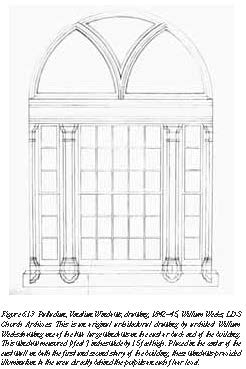 The east attic over the main building contained several skylight windows in the roof, as will be detailed in the next section describing that area. Also in the center of the gable or east end of the attic was “constructed the frame of a window twenty and a half feet in the , which forms four gothic windows, and three irregular triangles which partake of the eliptic and gothic." [93] A visitor to this attic area left this helpful description: “Coming down we were ushered into the Council Chamber, which is a large low room, lighted by one large half-circle window at the end and several small skylights in the roof." [94] No further descriptions or details can be found to determine the height or other features of this large end window.
The east attic over the main building contained several skylight windows in the roof, as will be detailed in the next section describing that area. Also in the center of the gable or east end of the attic was “constructed the frame of a window twenty and a half feet in the , which forms four gothic windows, and three irregular triangles which partake of the eliptic and gothic." [93] A visitor to this attic area left this helpful description: “Coming down we were ushered into the Council Chamber, which is a large low room, lighted by one large half-circle window at the end and several small skylights in the roof." [94] No further descriptions or details can be found to determine the height or other features of this large end window.
There is clear evidence to indicate that skylights were constructed at the top and on each side of the decked roof over the east attic. If these reports are correct, then this main attic roof area contained a total of eighteen skylight windows. “Upon the top of the building, or deck . . . is constructed six octagon sky-lights through which light will be reached into the large room below." [95] This was the large central “council room” where the endowment ordinances were conducted. Lower on the roof on each side of the deck, there was a second set of six windows on each side of the roof. “In each of these roofs, is six square sky-lights through which, light will be reached into the small rooms immediately below." [96] These skylights provided light to each of the twelve offices on the sides of this east attic. Emily Austin, a non-Mormon who lived in Nauvoo and spent some fourteen years among the Latter-day Saints, described this east attic roof area, having visited the temple as a youth. She reported, “We went into every part of the temple except into the endowment room. We were, however, on top of that, and removed some of the windows and looked in, as we did not intend to leave the place until our curiosity was perfectly satisfied." [97]
Additional long, narrow windows were located in the tower. What appear to be shutters or open louvers are located in the bell section of the tower, and windows were provided in the observatory and clock section. An enlargement of the Chaffin daguerreotype shows that diamond-shaped glass panes are visible in both levels of these tower windows. [98]
At the east end or rear of the building were two large venetian or palladian-style windows measuring 9 feet 7 inches wide and 15 feet high. [99] One of these windows was on the level of the first story and the other on the level of the second story. What appears to be the architect’s drawing of these windows can be seen in Figure 6.14. The reconstruction drawings (see Figure 6.18) show a conceptual view of how the various windows may have appeared in both the walls and attic section of the temple’s east end.
The Roof The roof over the west front attic section had only a slight pitch and was covered with white pine shingles (see Figure 7.2). [100] As can be seen from artists’ sketches, daguerreotypes, and written descriptions, this attic section was enclosed by an artistic balustrade. The east portion of the attic over the main part of the building was enclosed by a pitched roof, which at its apex appeared to be near the same height as the west half-story front attic. This roof was made of “white pine shingles and [one inch] plank sheathing," [101] having “an admirable system of joining and joint covering." [102] At the top of this pitched roof there was a flatter area often described as a deck roof or promenade. [103] This deck roof was described in some detail by Lyman O. Littlefield: “We stand upon the top of the building, or deck, in which is constructed six octagon sky-lights through which light will be reached into the large room below. The deck is finished in the same manner that some of our eastern rooms is ceiled; or in other words in ceiling form, perfectly water tight,” possibly covered or sheeted with metal. He then went on to further describe the rest of the pitched roof: “At each side of the deck is a roof made of pine shingles perfectly matched and laid in the neatest manner. In each of these roofs, is six square sky-lights through which, light will be reached into the small rooms immediately below." [104] Access to this roof area was made possible through a small door located on the east side of the steeple’s base section. [105]
Near the bottom of the roof on each side were what were described as "two elegant ornamental chimneys of hewn stone, running through each roof." [106] The pitch of the roof was not severe and was described as “so nearly flat that ourself and companion walked all over it without difficulty or danger, approaching the sides where, grasping one of the chimneys, the sentries below looked like pigmies." [107]
The eave troughs at the edges of the roof were reported to have been lined or “sheeted with sixty-five hundred pounds of lead” and capable of holding “thirty barrels of water." [108] It had been planned to run rain water from the troughs of the eaves “into a large resevoir at the east end of the building from which the baptismal fount will be supplied with water." [109] No reports can be found to describe this reservoir unless it was the water storage tank located in the east end of the basement as described in the excavation reports. [110] Due to the early exodus from Nauvoo, it is likely that the proposed reservoir was never constructed.
Part of the roof had been covered by sheet lead as an experiment. As the Times and Seasons reported: “The first roof of the Temple, has been made of white pine shingles and plank. The second, (for a building which will cost about two millions) most probably, will be constructed of zinc, lead, copper, or porcelain. An experiment of sheet lead, covering a portion of the shingles, has already been made." [111]
A balustrade was built along the sides of the east attic, matching the one around the west attic. It appears that an additional matching balustrade was constructed at the ridge level of the pitched roof (around or enclosing the deck roof) over the main attic. This type of roof adaptation is visible in daguerreotypes of the building and is most clearly visualized in the Easterly daguerreotype (see Figure 3.7).
Front of the Temple
Entrance into the building was gained by passing through one of three large open archways into what might be called the outer court or front vestibule of the temple. This main front entrance was located on the west end of the building. The outer court was reached by climbing a flight of eight stone steps (each with an 8-inch rise), that ascended to a height of 5 feet 4 inches above ground. Inside the semicircular arched entrances were two additional steps (each with a 6-inch rise) that brought one to the level of the first story, some 6 feet 4 inches above ground level (see Figure 2.3). The steps and the front entrance can be seen clearly in Figure 2.3. The arched entrances were described as being 9 feet 7 inches wide and 21 feet high.
The open vestibule area measured 43 feet long from north to south and 17 feet wide or deep. On the inside, near each end of this outer court or vestibule were two large doors. [112] Passing through these, a person would then be in the first story of the building. The three central wall bays between pilasters at the front of the building were wider than similar bays on the sides of the building. This became necessary in order to accommodate the large entryways into the front vestibule. It also served as “a visual relief. This technique was employed by the early Greeks; it was called entasis." [113] “It is a characteristic employed anciently in Greek orders of architecture and in many examples of American Greek revival architecture of the 1820s through the 1840s." [114] A fairly accurate view of the front of the temple can be obtained by studying and comparing four sources: (1) the preliminary sketch by the architect (Figure 2.3); (2) the architectural rendering attributed to Baird and Nauvoo Restoration (Figure 1.2), which is an excellent work and the most accurate artistic reproduction of the temple (this sketch is correct except for the top of the steps, of which two were inside of the arched entrances; the windows of the front attic, which were rectangular rather than square; and the color of the dome, which was silver in color rather than gold); (3) the Chaffin daguerreotype, which is the best available photograph of the building (Figure 5.4); and, (4) the tintype photograph of the front ruins taken about 1850 (Figure 11.3).
East End of the Building There are no known photographs or confirmed sketches of this section of the building. Sources providing data on this portion of the structure furnish only minimal information and are limited to descriptions of some windows. These have been detailed and illustrated in the section above describing the various windows of the building. From these we know that on each of the two main stories there was a large venetian-style window, at least one of which measured 9 feet 7 inches wide by 15 feet high. [115]
The three central wall bays were of necessity wider than those on the sides. This would be essential in balancing the overall width of the east wall and to accommodate the large venetian windows in the center on each floor level. In the east end of the attic story there was also a large window 20½ feet in width. [116] Figure 2.2 shows William Weeks’s preliminary conception of how both ends of the building were to look prior to his revised design that changed the front gable to a rectangular boxlike front attic. It is believed that the east end of the building retained the same gable design and wide elliptical windows as earlier designed for both ends. [117] This area of the temple can be visualized by studying the historical reconstruction drawing (Figure 6.18).
The Grounds The level terrain of the temple block posed few problems in construction or landscaping. The grounds were intended for beautification and as a site for additional Church structures. No mention is made of landscaping in the available records, but the ground was cleared around the temple in June 1845. [118] Owing to the practice of the Saints to beautify their residences with flowers and shrubs, it is safe to conclude that some efforts were made to enrich the beauty of the temple grounds. It is questionable that extensive work was undertaken, however, or it would have been recorded; and if intended, it may have been set aside because of the exodus to the West. Had the Church been allowed to remain in Nauvoo, the grounds around the temple undoubtedly would have been covered with trees, flowers, and shrubbery similar to Church temple sites today.
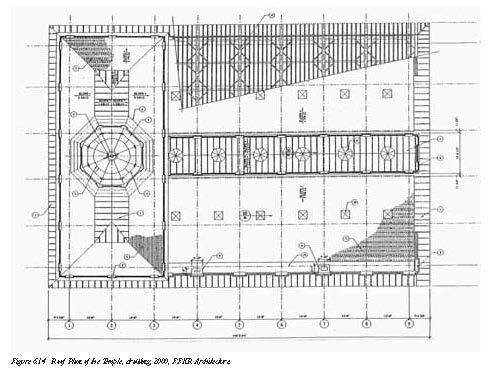 Of particular interest is a project commenced in the spring of 1845. Part of a planned improvement of the grounds, it was announced in the Times and Seasons: “A trench is being excavated about six feet wide and six feet deep, around a square of about six or eight acres, which will be filled with stone, and upon which will be placed an iron fence for the security of the Temple, and Tabernacle." [119] As reported by Brigham Young in late June 1845, the project was to be an iron picket fence 8 feet high, with a 5-foot-thick foundation at the base. He stated that the wall on the north side was nearly complete at that time. [120] In a letter of Brigham Young published 15 July 1845 in the Millennial Star, it is stated that the fence would also enclose the block west of the temple. [121] This massive project would also have been completed and made its contribution to the beauty of the grounds had the Saints been permitted to stay in Nauvoo to enjoy their city and temple. As guards were placed around the temple for security purposes, a watch house was built near the southwest corner of the building. This can be viewed by examining daguerreotypes of the building (Figures 5.4 and 8.14). Pine torches and lanterns were utilized to illuminate the temple grounds at night. The builders had “4 large lanterns made for the purpose and placed 25 feet from each corner of the Temple to keep a light by night." [122]
Of particular interest is a project commenced in the spring of 1845. Part of a planned improvement of the grounds, it was announced in the Times and Seasons: “A trench is being excavated about six feet wide and six feet deep, around a square of about six or eight acres, which will be filled with stone, and upon which will be placed an iron fence for the security of the Temple, and Tabernacle." [119] As reported by Brigham Young in late June 1845, the project was to be an iron picket fence 8 feet high, with a 5-foot-thick foundation at the base. He stated that the wall on the north side was nearly complete at that time. [120] In a letter of Brigham Young published 15 July 1845 in the Millennial Star, it is stated that the fence would also enclose the block west of the temple. [121] This massive project would also have been completed and made its contribution to the beauty of the grounds had the Saints been permitted to stay in Nauvoo to enjoy their city and temple. As guards were placed around the temple for security purposes, a watch house was built near the southwest corner of the building. This can be viewed by examining daguerreotypes of the building (Figures 5.4 and 8.14). Pine torches and lanterns were utilized to illuminate the temple grounds at night. The builders had “4 large lanterns made for the purpose and placed 25 feet from each corner of the Temple to keep a light by night." [122]
Church leaders recognized that the temple would accommodate only a small portion of the growing congregation, so an effort was made to provide additional meeting space. Prior to his death, Joseph Smith counseled the Saints to erect a tabernacle on the temple block. [123] Consequently, Brigham Young appointed Orson Hyde to chair the project, raise the required funds, and purchase the materials. This action was taken in June 1845. The structure was to be made of canvas and would cost between one and two thousand dollars. [124] Hyde went east to purchase the four thousand yards of cloth, and an Elder Egan went to St. Louis to purchase 125 dollars worth of hemp for making rope. [125] Orson Pratt described Hyde’s mission and the proposed tabernacle: “Pres. Orson Hyde . . . is now in the east. His mission is to collect tything for the purpose of purchasing 4000 yards of canvas in this city. It is intended to erect a tabernacle of canvas in front of, and joining the Temple on the west. The form of this tabernacle will be that of an ellipse; its longer axis running north and south, parallel to the front of the Temple. Its height will be 75 feet in the centre; its sides sloping at an angle of 45 degrees. The area of its base will be sufficient to contain eight or ten thousand persons; its seats will gradually rise one above another in the form of an amphitheatre. This will be intended for preaching to the vast congregation; while the temple will be used for the meeting of councils and quorums, and the administrations of ordinances and blessings, and preaching to smaller congregations." [126]
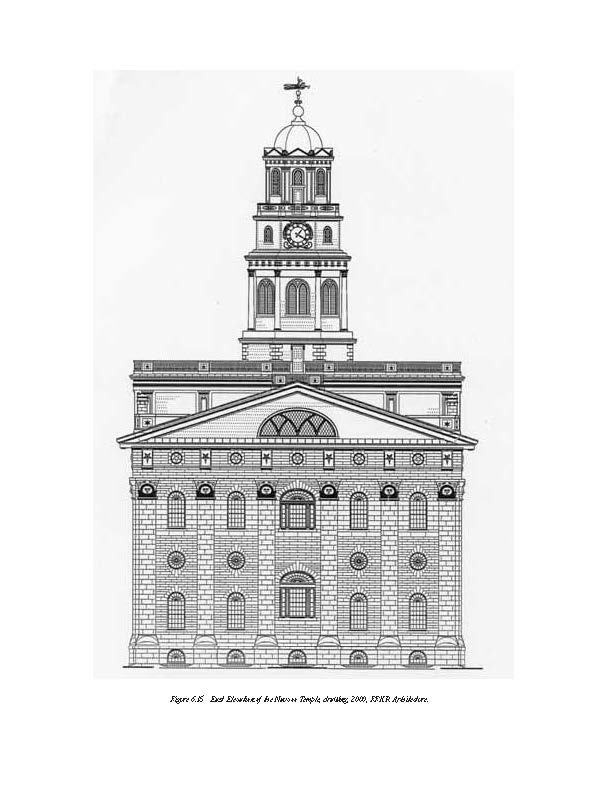 It is estimated that “the Nauvoo Tabernacle would have been approximately 250 feet long and 125 feet wide." [127] Hyde’s mission was successful. Visiting the main branches of the Church in the East, he succeeded in raising the required funds. He purchased the canvas and had it shipped to Nauvoo. [128] On Saturday, 18 October, Heber C. Kimball reported that Orson Hyde had “returned home from the east and brought five thousand yards of topsail Russia duck." [129] Since an exodus had been announced and was being planned for the following spring, use of the canvas was now diverted for tents and wagon covers. [130] Some of it was utilized in the attic story of the temple to partition the large council room of the east attic for performance of the endowment ordinances. [131] This canvas was later removed from the temple when ordinance work ceased and was likely utilized for tents and wagon covers.
It is estimated that “the Nauvoo Tabernacle would have been approximately 250 feet long and 125 feet wide." [127] Hyde’s mission was successful. Visiting the main branches of the Church in the East, he succeeded in raising the required funds. He purchased the canvas and had it shipped to Nauvoo. [128] On Saturday, 18 October, Heber C. Kimball reported that Orson Hyde had “returned home from the east and brought five thousand yards of topsail Russia duck." [129] Since an exodus had been announced and was being planned for the following spring, use of the canvas was now diverted for tents and wagon covers. [130] Some of it was utilized in the attic story of the temple to partition the large council room of the east attic for performance of the endowment ordinances. [131] This canvas was later removed from the temple when ordinance work ceased and was likely utilized for tents and wagon covers.
A Work of Love
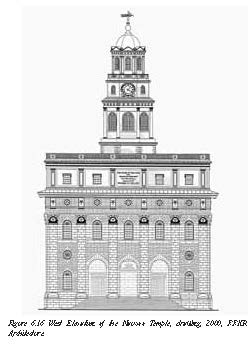 The exterior features of the temple seem to have been completed in every particular. The detail and excellence exhibited in carvings, polishing and texture, finishing of stonework, and painting of woodwork was widely praised. In light of conditions existing during construction, Church leaders could easily have opted for a course of expediency. They would have been justified in slapping together a utilitarian structure to get by until circumstances would allow building a better, more permanent building. Instead, and in spite of all obstacles, they chose to build as if they would live there for generations. It was from beginning to end a work of love, dedication, reverence, and highest quality. No effort was spared in producing the finest building possible. Only limited shortcuts were taken. As Tim Maxwell explains:
The exterior features of the temple seem to have been completed in every particular. The detail and excellence exhibited in carvings, polishing and texture, finishing of stonework, and painting of woodwork was widely praised. In light of conditions existing during construction, Church leaders could easily have opted for a course of expediency. They would have been justified in slapping together a utilitarian structure to get by until circumstances would allow building a better, more permanent building. Instead, and in spite of all obstacles, they chose to build as if they would live there for generations. It was from beginning to end a work of love, dedication, reverence, and highest quality. No effort was spared in producing the finest building possible. Only limited shortcuts were taken. As Tim Maxwell explains:
Shortcuts that may have been taken were only those that in fact improved the purpose or functions of the Temple. Around the second floor windows, sixteen-inch-high courses of stone were used consistently, where courses averaging eight inches had predominated in the courses below that. This is very apparent in a 16 by 20 enlargement of the Chaffin daguerreotype. From my experience as a youth in helping to open a stone quarry, and later in laying stone, I believe those in the Nauvoo quarry may have reached a better stratum of stone that was as easy to remove in large pieces as smaller. Less blasting powder would have been required for which the Temple accounts report they were paying $4.50 per bag. That compared to $2.50 per bag of white lead for paint. Fifty feet of “fuse rope” cost 75 cents. These were items that took scarce cash out of the community. It takes a little less labor to cut a large stone than to cut two smaller ones that total the same weight. Although larger stones must have given some inconsistent appearance to the facade, it actually improved quantity and performance of those courses.
The courses in the frieze appear in the daguerreotype to have been of rustic texture. While this was somewhat less time-consuming than many of the textures used lower on the building, it was an esthetic improvement, helping to emphasize the capping of the walls, and enhancing the shadow effect under the eaves. [132]
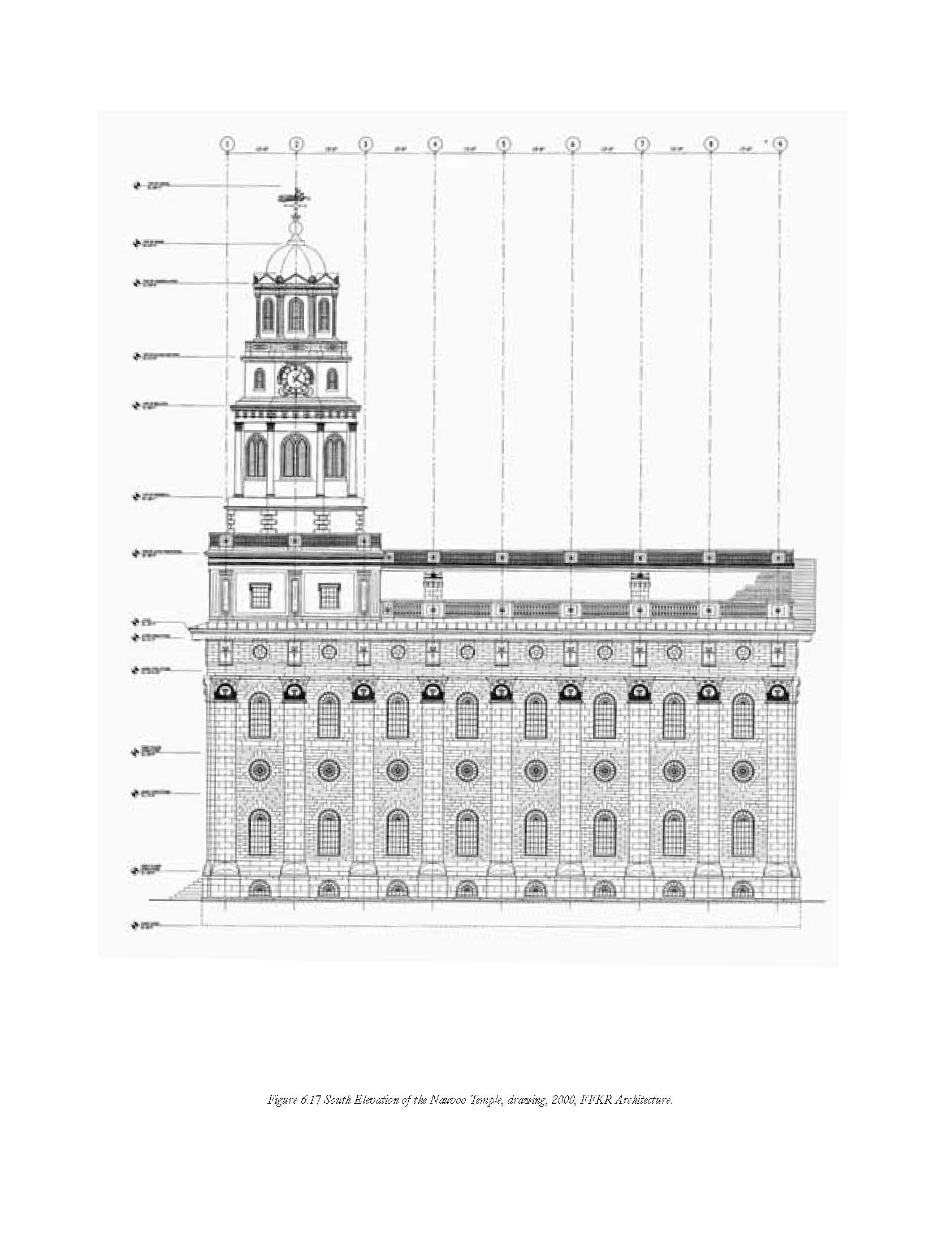 For six eventful years, Church members had shared a focus on building the temple and looking forward to its use and the blessings it would bring. After all this sacrifice and toil, one can only imagine the emotions they felt as they left this magnificent building to depart into the wilderness. It was for many as hard to leave their beloved temple as it was to leave behind their comfortable homes. Priddy Meeks reflected the feelings common to many: “While crossing over a ridge seven miles from Nauvoo, we looked back and took a last sight of the Temple we ever expected to see. We was sad and sorrowful. The emotions of our mind at that time I cannot describe." [133] A typical last look back by departing exiles is recorded by Lewis Barney: “On reaching the summit between the Mississippi and Des Moines Rivers the company made a halt for the purpose of taking a last and peering look at the Nauvoo Temple. The spire of which was then glittering in the bright shining sun. The last view of the temple was witnessed in the midst of sighs and lamentations all faces in gloom and sorrow bathed in tears at being forced from our homes and Temple that had cost us so much toil and suffering to complete its erection." [134]
For six eventful years, Church members had shared a focus on building the temple and looking forward to its use and the blessings it would bring. After all this sacrifice and toil, one can only imagine the emotions they felt as they left this magnificent building to depart into the wilderness. It was for many as hard to leave their beloved temple as it was to leave behind their comfortable homes. Priddy Meeks reflected the feelings common to many: “While crossing over a ridge seven miles from Nauvoo, we looked back and took a last sight of the Temple we ever expected to see. We was sad and sorrowful. The emotions of our mind at that time I cannot describe." [133] A typical last look back by departing exiles is recorded by Lewis Barney: “On reaching the summit between the Mississippi and Des Moines Rivers the company made a halt for the purpose of taking a last and peering look at the Nauvoo Temple. The spire of which was then glittering in the bright shining sun. The last view of the temple was witnessed in the midst of sighs and lamentations all faces in gloom and sorrow bathed in tears at being forced from our homes and Temple that had cost us so much toil and suffering to complete its erection." [134]
Notes
[1] Hancock Eagle, 24 April 1846.
[2] Charles Lanman, A Summer in the Wilderness (New York: D. Appleton, 1847), 31.
[3] Journal History, 12 June 1844, LDS Church Archives, citing Saint Louis Gazette and Nauvoo Patriot, 8 December 1856; also, Deseret News, 20 February l937.
[4] James L. Kimball Jr., “Nauvoo Restoration Pioneer: A Tribute,” BYU Studies 32, nos. 1–2 (winter and spring 1991): 96.
[5] Dennis Rowley, “Nauvoo: A River Town,” BYU Studies 18, no. 2 (winter 1978): 258.
[6] Thomas Gregg, Missouri Republican, as cited in David R. Crockett, Saints in the Wilderness (Tucson: LDS Gems, 1997), 186.
[7] New-York Messenger 2 (30 August 1845): 68.
[8] Hancock Eagle, 24 April 1846; also, Journal History, 15 June 1843.
[9] Journal History, 12 June 1844.
[10] Lanman, A Summer in the Wilderness, 31.
[11] Joseph Fielding, “The Nauvoo Journal of Joseph Fielding,” ed. Andrew F. Ehat, BYU Studies 19, no. 2 (winter 1979): 158.
[12] John W. Gunnison, The Mormons, or, Latter-day Saints in the Valley of the Great Salt Lake (Philadelphia: J. B. Lippincott, 1856), 116; also, Jenson, Historical Record 8 (June 1889): 858.
[13] Laurel Andrew, “The Nineteenth-Century Temple Architecture of the Latter-day Saints” (Ph.D. diss., University of Michigan, 1973), 90.
[14] Ibid., 90–91.
[15] Stanley B. Kimball, “The Nauvoo Temple,” Improvement Era, November 1963, 982.
[16] New-York Messenger 2 (20 September 1845): 93; also, The Prophet, 30 November 1844; also, Journal of William Clayton, “History of the Nauvoo Temple,” 6, LDS Church Archives; Times and Seasons 5 (1 January 1845): 759; W. W. Phelps to William Smith, 25 December 1844, LDS Church Archives; also, Frederick Hawkins Piercy, Route from Liverpool to Great Salt Lake Valley, ed. James Linforth (London: Latter-day Saints’ Book Depot, 1855), 67.
[17] Virginia S. Harrington and J. C. Harrington, Rediscovery of the Nauvoo Temple (Salt Lake City: Nauvoo Restoration, 1971), 17; also, William A. Gallup Journal Entry, 1848, LDS Church Archives; also, a writer for the Peoria Democratic Press of 29 May 1844, “claimed to have seen a ‘diagram model’ of the temple which was shown to him by Joseph Smith [and which] gives the dimensions as 130 by 90,” as cited in Kimball, “The Nauvoo Temple,” 982.
[18] Harrington and Harrington, Rediscovery of the Nauvoo Temple, 17.
[19] Andrew, “Temple Architecture,” 102.
[20] New-York Messenger 2 (30 August 1845): 68; and Nauvoo Neighbor, 30 July 1845.
[21] Deseret Evening News, 7 March 1876, citing an article from the Cincinnati Times, n.d.
[22] Deseret News, 30 September 1857.
[23] Chillicothe Advertiser 16 (25 July 1846): 1, as cited in J. Earl Arrington, “Story of the Nauvoo Temple,” 37, LDS Church Archives.
[24] Liberty Hall and Cincinnati Gazette 40 (19 October 1843): 1, as cited in Arrington, “Story of the Nauvoo Temple,” 37.
[25] Harrington and Harrington, Rediscovery of the Nauvoo Temple, 13.
[26] Jerry McElvain and Tim Maxwell, telephone conversation with author, 7 June 2000. Jerry McElvain and Uriel Schlair served as consulting architects on the Nauvoo Temple reconstruction project with special assignment to stone anchoring and quality characteristics of stone used in the temple. They carefully studied and examined 100 to 150 stones that were part of the original Nauvoo Temple. These studies provided clear evidence regarding finish and texturing used on stones in various parts of the structure. Tim Maxwell is an architect who worked on the Nauvoo Temple historical reconstruction drawings, as well as plans for the reconstructed temple at Nauvoo. He spent several years working with Nauvoo Restoration, and he studied extensively other stonework in old Nauvoo as well as other buildings of that time period.
[27] Hancock Eagle, 8 May 1846.
[28] New York Herald, 6 September 1846.
[29] Tim Maxwell, personal communication.
[30] Lanman, A Summer in the Wilderness, 32.
[31] Nauvoo Neighbor, 1 May 1844.
[32] Hancock Eagle, 24 April 1846. See also The Missouri Reporter, 5 (2 May 1846): 2, as cited in J. Earl Arrington, “Story of the Nauvoo Temple,” 3.
[33] The Prophet, 5 April 1845.
[34] B. H. Roberts, ed., History of the Church of Jesus Christ of Latter-day Saints, Period 2: Apostolic Interregnum (Salt Lake City: Deseret Book, 1932), 7:323.
[35] Arrington, “Story of the Nauvoo Temple,” 37a. During 1946 Arrington measured stones that had been taken from the ruins of the Nauvoo Temple and used in other buildings then standing.
[36] Nauvoo Neighbor, 30 July 1845.
[37] A report in the Liberty Hall and Cincinnati Gazette 40 (19 October 1843): 1, as cited in Arrington, “Story of the Nauvoo Temple,” 10, describes the temple basement as “about 12 feet in the clear, half of which is underground.” Harrington and Harrington, Rediscovery of the Nauvoo Temple, 16, confirms that the foundation walls of the excavated basement were about 5 feet below the ground level. The floor of the first story was 6 feet 4 inches above ground level. This level of the first story floor would include the 12 feet of the basement walls, plus the 1-foot-thick beam supporting the first floor. The original basement floor at the outside walls was somewhere between 5 feet 8 inches and 6 feet 8 inches below the ground level.
[38] Harrington and Harrington, Rediscovery of the Nauvoo Temple, 16.
[39] Liberty Hall and Cincinnati Gazette 40 (19 October 1843): 1, as cited in Arrington, “Story of the Nauvoo Temple,” 10.
[40] Truman O. Angell to John Taylor, 11 March 1885, as cited in Andrew, “Temple Architecture,” 88. “A ground plan must have been worked out and drafted in some detail during the latter part of 1840 so that initial preparation of the grounds could commence that fall. . . . Stone quarries were located and initial excavating commenced at the temple site. While quarry work proceeded slowly that winter, in February the foundation was laid out by the temple committee and digging of the cellar commenced. By March, cellar walls were started and foundation stones were being set. The walls were high enough by 6 April for a special cornerstone laying ceremony. William was present, he marched in the parade, and he then helped lower the first cornerstone into place._ J. Earl Arrington, “William Weeks, Architect of the Nauvoo Temple,” BYU Studies 19, no. 3 (spring 1979): 343.
The temple committee had evidently begun the construction of the temple, which was to be similar to Kirtland, but the basement was “much botched” by them. Truman O. Angell to John Taylor, 11 March 1885, LDS Church Archives. Joseph Smith’s history does not mention the name of the architect until 1843. But from the context it is clear that this person had been the temple architect for some time and was given total control over the building as a result of the “spoiling of the foundations.” “In consequence of misunderstanding on the part of the Temple committee, and their interference with the business of the architect, I gave a certificate to William Weeks to carry out my designs and the architecture of the Temple in Nauvoo, and that no person or persons shall interfere with him or his plans in the building of the Temple.” Smith, History of the Church, 5:353.
[41] Smith, History of the Church, 6:196–97; and Joseph Smith, Discourses of the Prophet Joseph Smith, comp. Alma Burton (Salt Lake City: Deseret Book, 1977), 267.
[42] New-York Messenger 2 (30 August 1845): 68; also, 2 (20 September 1845): 93.
[43] Doctrine and Covenants 76. The sun, represented by the sun stones, symbolizes the celestial degree of glory. The moon, represented by the moon stones, symbolizes the terrestrial degree of glory. The stars, represented by star stones and carved wooden stars, symbolize the telestial degree of glory.
[44] Journal of History 3 (April 1910): 163 as quoted in Saints’ Herald, 26 September 1949; and Josiah Quincy, Figures of the Past (Boston: Roberts Brothers, 1883), 389.
[45] These figures correlate with width measurements of the moon stones, which were 6 feet wide at their juncture with the pilaster base. Measurements were taken by Arrington as reported in “Story of the Nauvoo Temple,” 4, 39. The pilaster bases were the same height as the foundation walls.
[46] Liberty Hall and Cincinnati Gazette 40 (19 October 1843): 1, and Universalist Union 9 (June 1844): 407, as cited in Arrington, “Story of the Nauvoo Temple,” 2. A plinth is defined as “a square vertically faced member immediately below the . . . base of a column in classical architecture, . . . the lowest member of a pedestal.” Webster’s Third New International Dictionary (Springfield: Merriam-Webster, 1986) s.v. The plinths were put into the wall at just the time and in the same location (height) where the moon stones would have been placed. The first plinth was put in place on 11 June. By October the walls were up to the window sills, which were then all in place including the large sill on the eastern Venetian window. At this time there were two courses of stone on the plinths. Journal History, 11 October 1842. The daguerreotypes show that this would be at the level of two courses of stone above the moon stones. This establishes the plinths and the moon stones as one and the same. The plinths were cut by several individuals, and account books listed payment for four plinths to Pulaski Cahoon and two to George Ritchie, all at forty-five dollars for each plinth. “Nauvoo Temple Building Committee Records,” 5 September 1842, LDS Church Archives.
[47] New-York Messenger 2 (30 August 1845): 68.
[48] Arrington, “Story of the Nauvoo Temple,” 39.
[49] Missouri Reporter 5 (2 May 1846): 2, as cited in Arrington, “Story of the Nauvoo Temple,” 3.
[50] Ibid.
[51] Roberts, History of the Church, 7:323.
[52] Arrington, “Story of the Nauvoo Temple,” 39.
[53] Roberts, History of the Church, 7:323.
[54] Warsaw Signal, 11 September 1844.
[55] New-York Messenger 2 (30 August 1845): 68.
[56] Journal of History, 2 (1909): 464–65.
[57] Iowa Territorial Gazette and Advertiser 9 (18 April 1846): 1, as cited in Arrington, “Story of the Nauvoo Temple,” 49.
[58] Brigham Young, The Journal of Brigham, comp. Leland R. Nelson (Provo, Utah: Council, 1980), 112.
[59] New-York Messenger 2 (30 August 1845): 68.
[60] Times and Seasons 6 (1 August 1845): 983; also, New-York Messenger 2 (20 September 1845): 93.
[61] Journal History, 9 October 1848, citing an article in the Nauvoo Patriot, of the same date.
[62] New-York Messenger 2 (8 November 1845): 152.
[63] “The Old Temple,” Nauvoo Independent 17 (20 December 1889): 7.
[64] Iowa Territorial Gazette and Advertiser 9 (18 April 1846): 1, as cited in Arrington, “Story of the Nauvoo Temple,” 51.
[65] Ibid., also, Carthage Republican, 25 February 1864, as cited in E. Cecil McGavin, The Nauvoo Temple (Salt Lake City: Deseret Book, 1962), 95.
[66] Newell K. Whitney, Whitney Collection, Box 3, Folder 1, Harold B. Lee Library, Brigham Young University.
[67] Journal History, 30 January 1846.
[68] Iowa Territorial Gazette and Advertiser 9 (18 April 1846): 1, as cited in Arrington, “Story of the Nauvoo Temple,” 51. Arrington makes this conclusion based on this and other reports describing the angelic weather vane.
[69] Perrigrine Sessions, The Diaries of Perrigrine Sessions (Bountiful, Utah: Carr, 1967), 43–44.
[70] Iowa Territorial Gazette and Advertiser 9 (18 April 1846): 1, as cited in Arrington, “Story of the Nauvoo Temple,” 516.
[71] Whitney Collection, Box 3, Folder 6.
[72] Ibid., Box 3, Folder 1.
[73] New-York Messenger 2 (8 November 1845): 152.
[74] Deseret Evening News, 7 March 1876, citing an article from the Cincinnati Times, n.d.
[75] Thomas L. Kane, The Mormons: A Discourse (Philadelphia: King and Baird, 1850), 20.
[76] Joseph Smith III, Joseph Smith III and the Restoration, ed. Mary Audentia Smith Anderson (Independence, Mo.: Herald House, 1952), 100.
[77] New-York Messenger 2 (30 August 1845): 68; and Nauvoo Neighbor, 30 July 1844.
[78] New York Herald, 6 September 1846.
[79] New-York Messenger 2 (30 August 1845): 67–68.
[80] Ibid. (8 November 1845): 152.
[81] Liberty Hall and Cincinnati Gazette 40 (19 October 1843): 1, as cited in Arrington, “Story of the Nauvoo Temple,” 30.
[82] New-York Messenger 2 (30 August 1845): 68.
[83] The original drawing has measurements along the side that provide clear evidence on the size of these windows.
[84] Account books for the temple show quantity purchase of window panes measuring 10 by 14 inches. This size fits consistently with measurements of these large main windows. Account books are found in LDS Church Archives. They have been microfilmed and fill five full reels. Glass purchases, along with blasting powder, fuse, and iron, are periodically cited throughout all of the building committee account books.
[85] Tim Maxwell, personal communication, from extensive research in Nauvoo Temple architectural drawings, account books, and billing records.
[86] The original drawing has measurements along the side that provide clear evidence on the size of these windows.
[87] Charles A. Dana, The United States Illustrated (New York: H. J. Meyer, 1855), 1:39–40, as cited in Arrington, “Story of the Nauvoo Temple,” 32.
[88] New-York Messenger 2 (30 August 1845): 67–68.
[89] Illinois Journal, 9 December 1853, as reprinted in Journal of Illinois State Historical Society 38 (1945): 483; also, New-York Messenger 2 (30 August 1845): 68.
[90] Emily M. Austin, Mormonism; or, Life among the Mormons (New York: AMS, 1971), 201.
[91] Ibid.
[92] Maxwell, personal communication.
[93] New-York Messenger 2 (30 August 1845): 68.
[94] Ibid., 67–68.
[95] Ibid., 68.
[96] Ibid.
[97] Austin, Mormonism; or, Life among the Mormons, 201, 202.
[98] Maxwell, personal communication. Observations made after careful study of an enlarged copy of the Chaffin daguerreotype.
[99] New-York Messenger 2 (30 August 1845): 67–68. No definitive records have been found to indicate how many of these windows were placed in this end of the building. However, careful study of the back end of the Kirtland and St. George Temples leads to the conclusion that the same general pattern was followed in Nauvoo as was used in these temples. They each had one large window on each level. William Weeks may have studied the Kirtland Temple plans; his assistant, Truman O. Angell, who was the architect of both the St. George and Salt Lake Temples, seems to have followed much of the general pattern of Nauvoo as he constructed the temple in St. George. Documentation on the numbers of main and larger circular windows also supports the conclusion of just one large venetian-style window on each main story.
[100] The of the roof was 38 feet with a rise in the center of the pitched roof of 4 feet 6 inches. This would be a rise of less than 3 inches per foot.
[101] New-York Messenger 2 (20 September 1845): 93; also Times and Seasons 6 (1 August 1845): 983.
[102] New York Herald, 6 September 1846.
[103] Maysville Eagle 12 (26 October 1846): 2, as cited in Arrington, Story of the Nauvoo Temple, 5.
[104] New-York Messenger 2 (30 August 1845): 68.
[105] Journal History, 9 October 1848, citing an article in the Nauvoo Patriot of the same date. “On Monday (October 9th) our citizens were awakened by the alarm of fire, which, when first discovered, was bursting out through the spire of the temple, near the small door that opened from the East side to the roof, on the main building.”
[106] New-York Messenger 2 (30 August 1845): 68.
[107] Mr. Davidson, editor of the Carthage Republican, as cited in E. Cecil McGavin, Nauvoo the Beautiful (Salt Lake City: Stevens and Wallis, 1946), 39.
[108] New-York Messenger 2 (30 August 1845): 68.
[109] Ibid.
[110] Harrington and Harrington, Rediscovery of the Nauvoo Temple, 32.
[111] Times and Seasons 6 (1 August 1845): 983.
[112] New-York Messenger 2 (30 August 1845): 67.
[113] Steve Goodwin, personal communication, from extensive research in Nauvoo Temple architectural drawings and study of Greek Revival architecture. He is an architect who worked on the plans for the reconstruction of the Nauvoo Temple.
[114] Maxwell, personal communication.
[115] New-York Messenger 2 (30 August 1845): 67–68.
[116] Ibid., 68.
[117] Maxwell, personal communication.
[118] Roberts, History of the Church, 7:431.
[119] Times and Seasons 6 (1 April 1845): 856.
[120] Roberts, History of the Church, 7:427, 431.
[121] Millennial Star 6 (15 July 1845): 43.
[122] Hosea Stout, On the Mormon Frontier, the Diary of Hosea Stout 1844–1861, ed. Juanita Brooks (Salt Lake City: University of Utah Press, 1964), 1:64.
[123] Roberts, History of the Church, 7:427.
[124] Ibid.
[125] Ibid., 431, 427.
[126] New-York Messenger 2 (30 August 1845): 67.
[127] Elden J. Watson, “The Nauvoo Tabernacle,” BYU Studies 19, no. 3 (spring 1979): 420.
[128] Roberts, History of the Church, 7:482–83.
[129] Helen Mar Whitney, “Scenes in Nauvoo and Incidents from H. C. Kimball’s Journal,” Woman’s Exponent 11 (15 May 1883): 186.
[130] Watson, “Nauvoo Tabernacle,” 421.
[131] Catherine Lewis, Narrative of Some of the Proceedings of the Mormons (Lynn, Mass.: Catherine Lewis, 1848), 7–8.
[132] Maxwell, personal communication.
[133] Priddy Meeks Journal, 22 October 1879, LDS Church Archives.
[134] Lewis Barney, The Life of Lewis Barney as Written by Himself (Duncan, Ariz.: Clifford Page Sanders, 1988), 28.
